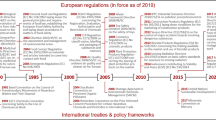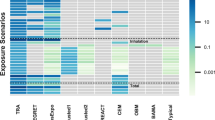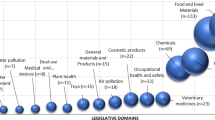Abstract
ECETOC has been developed an approach by which the health and environmental risks arising from the supply and use of chemicals can be quickly and reliably evaluated by chemical suppliers. The approach has been available as a web-based tool since 2004. During the development and implementation of the approach, ECETOC has consulted widely so that the approach is seen to meet the required levels of science while also meeting the differing needs of affected stakeholders. The consultation process has yielded a number of findings in terms of the considerations necessary for implementing successful risk-informed decision-making in a multi-stakeholder environment. Concurrently, as the European Commission's REACH legislative package has begun to take shape, it has also become apparent that the approach has a number of potential applications for aiding the process of risk assessment under REACH. This paper reviews these experiences within the broader context of the expectations that REACH places on chemical manufacturers and suppliers. In particular, it highlights the key role that REACH Exposure Scenarios have for evaluating, managing and communicating chemical risks.
This is a preview of subscription content, access via your institution
Access options
Subscribe to this journal
Receive 6 print issues and online access
$259.00 per year
only $43.17 per issue
Buy this article
- Purchase on Springer Link
- Instant access to full article PDF
Prices may be subject to local taxes which are calculated during checkout



Similar content being viewed by others
References
Barlow S.M., Kozianowsky G., Würtzen G., and Schlatter J. Threshold of toxicological concern for chemical substances present in diet. Food Chem Toxicol (2001): 39: 893–905.
Briggs D., and Crumbie N. Characteristics of People Working With Chemical Products in Small Firms, Health & Safety Executive Contract Research Report 278, HMSO, Norwich, (2000).
Brooke I.M. A UK Scheme to Help Small Firms Control Health Risks from Chemicals: Toxicological Considerations. Ann Occup Hyg (1998): 42: 377–390.
CIA. Safe Handling of Colourants 2. Chemical Industries Association, London, (1993).
Creely K.S., Tickner J., Soutar A.J., Hughson G.W., Pryde D.E., Warren N.D., Rae R., Money C., Phillips A., and Cherrie J.W. Evaluation and further development of EASE model 2.0. Ann Occup Hyg (2005): 49: 135–145.
ECETOC. Targeted Risk Assessment, Technical Report No. 93, European Centre for the Ecotoxicology and Toxicology of Chemicals, Brussels, (2004).
European Commission. White Paper on the Strategy for a Future Chemicals Policy. Document COM(2001)88, Brussels, (2001).
European Commission. Proposal for a Regulation of the European Parliament and of the Council Concerning the Registration. Evaluation, Authorisation and Restriction of Chemicals (Reach) Document (COM(03) 644 (01)), Brussels, (2003).
Guest I. The Chemical Industries Association Guidance on Allocating Occupational Exposure Bands. Ann Occup Hyg (1998): 42: 407–411.
HERA. Five years ahead of REACH. European Voice (2005): 11 (13).
JRC. RIP 3.2-1 Scoping report. Technical Guidance Document on preparing the Chemical Safety Report under REACH – Scoping Study – Phase 1 A (REACH Implementation Project 3.2-1A) Service Contract Number 22551-2004-12 F1SC ISP BE, EU Joint Research Centre, Ispra, (2005).
Kroes R., Galli C., Munro I., Schilter B., Tran L-A., Walzer R., and Würtzen G. Threshold of toxicological concern for chemical substances present in the diet: a practical tool for assessing the need for toxicity testing. Food Chem Toxicol (2000): 34: 829–867.
Maidment S.C. Occupational hygiene considerations in the development of a structured approach to select chemical control strategies. Ann Occup Hyg Hygiene (1998): 42: 391–400.
McKee R.H., Medeiros A.M., and Daughtrey W.C. A proposed methodology for setting occupational exposure limits for hydrocarbon solvents. J Occup Environ Hyg (2005): 2: 524–542.
Money C. European approaches in the development of approaches for the successful control of workplace health risks. Ann Occup Hyg (2003): 47: 533–540.
Money C., de Rooij C., Floch F., Jacobi S., Koundakjian P., Lanz S., Penman M., Rodriguez C., and Veenstra G. A structured approach to the evaluation of workplace health risks'. Policy and Practice in Health and Safety (2003): 2: 44–65.
Naumann B.D., Sargent E.V., Starkman B.S., Fraser W.J., Becker G.T., and Kirk G.D. Performance-based exposure control limits for pharmaceutical active ingredients. Am Ind Hyg Assoc J (1996): 57: 33–42.
O'Hara J., Williamson J., Benjamin K., Marlow P., White J., and Wright S. E-COSHH Essentials Guidance Sheets: User Consultation Exercise, Health and Safety Laboratory Report RAS/03/10, HSL, Sheffield., (2003).
Schneider T., Vermeulen R., Brouwer D., Cherrie J., Kromhout H., and Fogh C. A conceptual model for assessment of dermal exposure. Occup and Environ Med (1999): 56: 765–773.
Verdonck F.A.M., Boije G., Vandenberghe V., Comber M., de Wolf W., Feijtel T., Holt M., Koch V., Lecloux A., Sibel-Sauer A., and Vanrolleghem P.A. A rule-based screening environmental risk assessment tool derived from EUSES. Chemosphere (2005): 58: 1169–1176.
Author information
Authors and Affiliations
Corresponding author
Rights and permissions
About this article
Cite this article
Money, C., Jacobi, S., Penman, M. et al. The ECETOC approach to targeted risk assessment; lessons and experiences relevant to REACH. J Expo Sci Environ Epidemiol 17 (Suppl 1), S67–S71 (2007). https://doi.org/10.1038/sj.jes.7500565
Received:
Accepted:
Published:
Issue Date:
DOI: https://doi.org/10.1038/sj.jes.7500565
Keywords
This article is cited by
-
European solvent industry group generic exposure scenario risk and exposure tool
Journal of Exposure Science & Environmental Epidemiology (2014)



